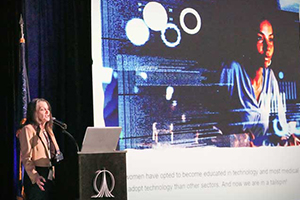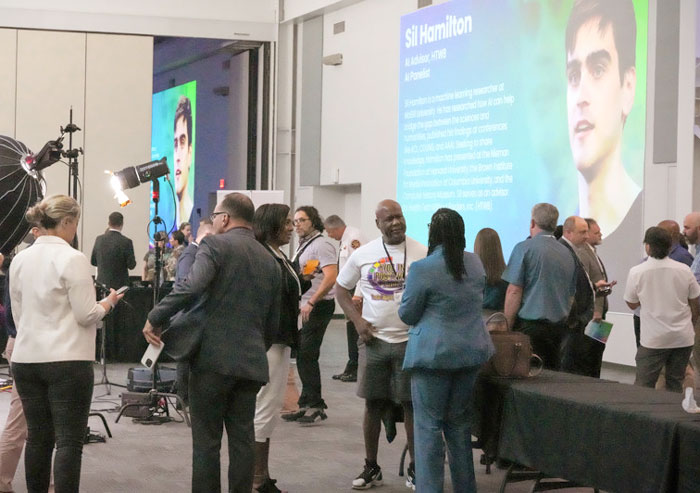Feb 21, 2024
CommHIT Shoots for the Moon
 Dr. Kendra Siler is a
scientist at heart. As President and CEO of the
Florida-based nonprofit CommHIT, Siler works with rural
health organizations to "plan and operationalize programs
that deal with combinations of community, health, and
technology" — but she approaches the work with
a perspective shaped in the lab.
Dr. Kendra Siler is a
scientist at heart. As President and CEO of the
Florida-based nonprofit CommHIT, Siler works with rural
health organizations to "plan and operationalize programs
that deal with combinations of community, health, and
technology" — but she approaches the work with
a perspective shaped in the lab.
"For my PhD, I worked with biochemical pathways in cells," said Siler. "Looking at what binds to what? What's the effect? What do you need in the cell's environment or milieu? What's slowing down or speeding up interconnected reactions? Logistically, my mind is always applying cell science to rural issues."

Since CommHIT was founded in 2008, Siler and her colleagues have approached some of the biggest challenges in rural health with this same spirit of curiosity and experimentation. The organization developed the first rural-based health information exchange (HIE), an innovative transportation model, and has spearheaded numerous other projects and initiatives.
According to Dr. David Willis, Chief Medical Information Officer, CommHIT specializes in "expanding opportunities for practices, providers and facilities that get left on the fringe with big steamroller advancements" in policy and technology. "That's where we've really found our niche, in helping those communities," said Willis.

Now, as an awardee of the Federal Office of Rural Health Policy (FORHP) Rural Public Health Workforce Training Network (RPHWTN) grant program, CommHIT is focusing on cybersecurity and rural workforce development. The Community Connected Care Workforce Program (C3w+) launched in 2022 with a goal to provide "training and credentials to upskill current and potential workers, help rural health organizations address workforce shortages, and bolster digital literacy and security by focusing on the development of health technology, community paramedicine, and community health workers."
The program encompasses numerous initiatives, broadly divided into two "zones." The "Community Paramedicine (CP) Zone" supports the development of the rural community health workforce, such as community health workers (CHWs) and community paramedics. The "Tech Zone" offers cybersecurity and other technology-related trainings to rural hospitals and other organizations. The program also supports apprenticeships for cyber first responders, telehealth navigators, and community paramedics.
It's affecting communities in more ways than just improving their healthcare. It's improving productivity and economic health as well.
With partners in rural communities across the state of Florida, C3w+ is already starting to see promising results. As a result of the trainings and apprenticeships supported by the program, "we have people getting jobs, getting credentialed, getting promotions," said Siler. "It's affecting communities in more ways than just improving their healthcare. It's improving productivity and economic health as well."
Origins and Evolution
CommHIT was founded in 2008 with funding from another FORHP initiative, the Rural Health Network Development (RHND) Program. The organization's original purpose was to assist rural health organizations with the transition to e-prescribing and electronic health records (EHRs). Then, with the passing of the HITECH Act of 2009, CommHIT began helping partners meet meaningful use requirements for EHRs.
"At the time, the meaningful use policies required rural health organizations to implement EHRs and then start exchanging data outside of their four walls," said Siler. "We wanted to make sure that there was an HIE for them to use, so we created the framework for that."
In 2011, CommHIT received another FORHP RHND grant to operationalize MyHealthStory, the first rural-based HIE in the nation. MyHealthStory eventually grew to include organizations in 15 counties throughout north central Florida. In 2013, Siler and Willis each received a Critical Access and Rural Hospital Champion Award from the Office of the National Coordinator for Health Information Technology. The award recognized the "groundbreaking collaborative efforts these individuals have taken with public and private sector partners to accelerate Meaningful Use among CAHs and small, rural hospitals nationwide."
We just kind of rolled and adapted and started to fill in other gaps that the larger systems weren't fulfilling for smaller practices and rural spaces.
Eventually, as "vendors changed and needs changed and technology changed," the HIE mostly "evolved out of existence, just like it evolved into existence," said Willis. But by that point, the range of CommHIT's interests had expanded well beyond health information technology (HIT) and EHRs. "We just kind of rolled and adapted and started to fill in other gaps that the larger systems weren't fulfilling for smaller practices and rural spaces," he said.
For instance, in 2013, CommHIT became an FCC-approved Consortium for the Healthcare Connect Fund. In this role, they help rural healthcare organizations secure reimbursement for eligible broadband expansion projects. "We've gotten back close to $20 million for 35 medical facilities since 2013," said Siler.
In 2016, CommHIT's longstanding interest in cybersecurity — dating back to their work on the HIE — earned the organization an invitation to the Kennedy Space Center, where they are currently headquartered. "We got a call from the immediate past Department of Homeland Security Cybersecurity Director asking if we wanted to come out to the Space Center and stand up an ISAC," recalled Siler.
An information sharing and analysis center (ISAC) is an entity that provides cyber threat intelligence and analysis to members, including rural health organizations. Today, CommHIT operates two ISACs — one for healthcare organizations and the other for transportation agencies. CommHIT is also a founding partner of a new AI-ISAC at the Space Center, which launched in December.
Though CommHIT does not have a formal partnership with NASA, Siler and Willis see opportunities for more collaboration in the future. There is an "overlap of concepts" between rural health and space health, said Willis. In both cases, the basic challenge is to provide care for people who are far away from or have limited access to health resources.
Despite these interstellar possibilities, the vast majority of CommHIT's day-to-day work with partners requires a decidedly down-to-earth approach. Much of their current work with C3w+ involves helping organizations think through "the practical pieces that need to be in place" to initiate a community paramedicine program or cybersecurity training program, then drawing up detailed implementation plans.
"We're not in it to sell [our partners] a bunch of stuff, we're in it to help them solve their problems," said Willis. "Hopefully we can help avoid wasted time and wasted resources and enable them to excel and exceed their expectations in the projects that they want to undertake."
"I think the reason we have some of our success is because the end goal of our work with organizations is for them to become internally sustainable," said Siler. "Technology changes and change is necessary, so there's always more work for us to do. But when we go in and work on a project, it's not so we can come back and do more work. It's so organizations and communities can confidently run with the program and sustain it."
Leveraging Partnerships

CommHIT's longstanding partnership with the Professional Association of Healthcare Office Management (PAHCOM) offers one example of their approach. PAHCOM works with small practices across the country to provide resources and professional development to office managers (sometimes also referred to as practice managers or practice administrators). Currently, through the C3w+ "Tech Zone," CommHIT and PAHCOM are expanding technology and cybersecurity training for rural office managers and individuals looking to enter the profession.
PAHCOM Executive Director Karen Blanchette, MBA, recalled the experience that led to her organization's initial partnership with CommHIT: "A little over a decade ago, PAHCOM had a session at one of our conferences on cybersecurity and technology, and then in the room next door they were talking about, what personality color are you? If you're a blue, this is how you should talk to the yellows. And that room was packed, standing room only. But the cybersecurity room? Crickets. We knew that something had to be done."
In response, PAHCOM worked with CommHIT to develop the Health Information Technology Certified Manager for Physician Practice (HITCM-PP), an industry-recognized credential "created to validate and document a practice manager's knowledge and familiarity with those aspects of technology necessary for today's solo provider and small group physician practices." To obtain the credential, practice managers must demonstrate an understanding of HIT, HIT system analysis and maintenance, IT vendor contracts, and cybersecurity best practices, among other topics.
According to Blanchette, CommHIT played an "integral" role in the development of the HITCM-PP study guide and exam. They have also assisted with periodically updating the guide and exam as technologies change. From 2019 through 2023, CommHIT partnered with a U.S. Department of Labor-funded program to train and credential over 500 current and aspiring practice managers across the country. Now, through C3w+, they are targeting outreach to administrative staff at Rural Health Clinics (RHCs), Federally Qualified Health Centers (FQHCs), and other rural healthcare organizations throughout Florida.
CommHIT and PAHCOM see their work as increasing patient and organizational cybersecurity, while simultaneously offering an important workforce development opportunity for women in technology. According to Blanchette, women comprise 90% of the office management workforce but only 25% of the technology workforce. "Our partnership [with CommHIT] provides a career opportunity to hundreds of women working to gain the training necessary to become members of the technology workforce," she said.
Through the "CP Zone" of C3w+, CommHIT is leveraging another longstanding partnership to expand workforce development opportunities for CHWs. In 2018, CommHIT began working with the Florida Community Health Worker Coalition (FCHWC) to develop the Tech-Based Community Health Worker (CHW-T) credential and training program. CHW-Ts are trained to assist clients with digital literacy and cybersecurity, patient portal navigation, and remote patient monitoring; they are also trained on the use of a secure communications platform to connect patients with additional care. CHW-T training is now being offered freely to CHWs in rural counties across the state.

According to FCHWC President and Executive Director Dr. Lisa Hamilton, the program was created in direct response to feedback from CHWs. Back in 2018, "one of the things that was brought to our attention was the need for more technology training," said Hamilton. She described the development of the program as a collaborative process, with FCHWC communicating needs and information from the "boots on the ground," and CommHIT supplying the technological expertise.
In 2021, new feedback from FCHWC members led to another collaboration with CommHIT. From a biannual member survey, FCHWC learned that many CHWs were interested in more opportunities for career advancement — with many respondents expressing particular interest in working as community paramedics. Over the past several months, CommHIT has been meeting with FCHWC and other "CP Zone" partners to "create a pathway," said Hamilton.
"We would love for our CHWs to remain in the role of CHWs, because it's an exciting time for us," said Hamilton. "But they need to have an avenue in which to progress — and based on the information and data we've gathered, community paramedicine would definitely be a positive direction of growth."
The Road Ahead

In the years ahead, Siler and Willis expect workforce development and tech-related training to remain centerpieces of CommHIT's work. They attribute the increasing need for these services to two characteristics of the COVID-affected healthcare landscape: the ever-growing importance of digital literacy and the surge of interest in community paramedicine.
According to Siler, CommHIT has assisted with training "close to 2000 people in the last three years, either in direct care occupations or technology occupations." While the C3w+ program is exclusive to partners in rural Florida, CommHIT's various other initiatives have served partners in "48 states, DC, and four of the five US territories," said Siler.
In addition to his role at CommHIT, Willis works as a family medicine physician in the city of Ocala — and plans to continue practicing as CommHIT evolves and expands. He has worked previously as the Chief Medical Information Officer at a hospital and the Chief Medical Officer at an FQHC. "That inside knowledge has been invaluable," said Willis. "I think it keeps me more relevant because I can actually say, this works because I do it, or this works because I've done it."
Kendra and I have worked very hard to engender trust among our partners…
In some ways, he views his role at CommHIT and his role as a physician in similar terms. "As a physician, patients have to trust me for there to be an ongoing relationship," said Willis. "Kendra and I have worked very hard to engender trust among our partners, and we've maintained that trust through all these years so that now we have somebody who will refer somebody else to us because of that longstanding relationship."
Willis shared an anecdote from CommHIT's first annual summit, which took place in September 2023, to illustrate his hopes for the organization's future. The summit convened over 100 partners — including C3w+ program participants — at the Space Center for a day of presentations and discussions on the theme of "Achieving Today's Advanced Workplace."
One of the presenters, an ICU physician involved in global disaster relief, commented that "it was the first conference he had been to that was integrative," said Willis. "We had clinical professionals and IT professionals and social service people all talking about the same problems and the solutions that would solve those problems together. And he says that nobody has meetings like this. And I think we're excited about continuing to tell that integrated story and share the value that it brings."
